Civics - Class 6
Our Past - I
Chapter 8: Rural Livelihoods
Intext Questions:
Question 1. Describe the work that you see people doing in the pictures.
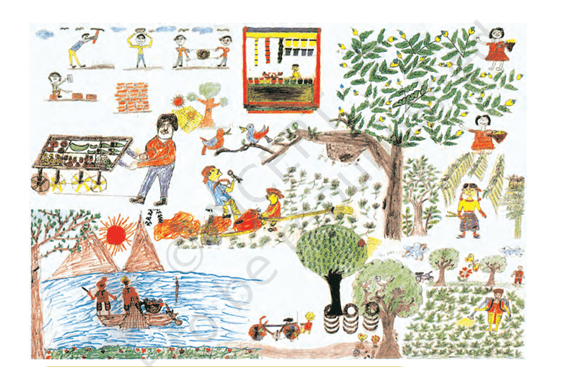
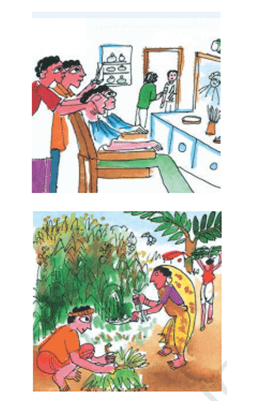
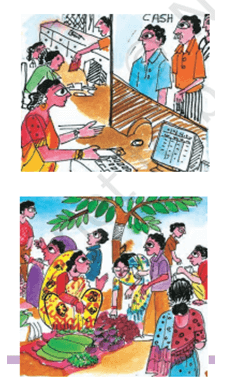
Answer:The work that people are doing includes:
- Labourers carrying loads
- Mansonries doing construction work
- Hawkers selling vegetables on the road side
- Fishing
- Plucking fruits and vegetables
- People supervising the work in the field
- Labourers working in the fields
Question 2. Identify the different type of work that/are related to farming and those that are not. List this in a table.
Answer:
| Work-related to farming | Work not related to agriculture |
|---|---|
|
|
Question 3. In your notebook draw some pictures of work that you have seen people do in rural areas and write a few sentences that describe the work.
Answer:
-
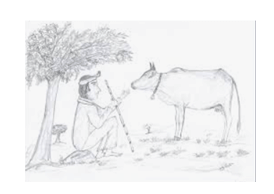
A Person herding cows and sitting under a tree in a day time and singing for satisfaction.
-
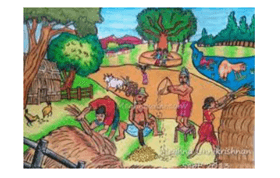
Farmers doing the aftermath work of harvesting.
-
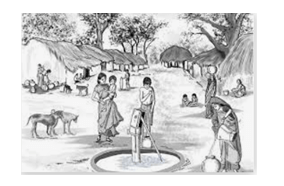
Village people doing the daily chores in a day like cleaning, bringing water, brooming, taking care of children etc...
Question 4. Describe the work that Thulasi does. How it is different from the work Raman does?
Answer:
- Thulasi works in the paddy field from 8.30 in the morning till 4.30 in the evening. She transplants the paddy when they have grown a little.
- She does all the work at home like cooking, cleaning the house and washing clothes. She goes to the nearby forest to collect firewood arid fetch water.
Raman is a labourer. He sprays pesticide on the sapling.
When there is no work on the farm, he finds work loading sand from the river or stone from the quarry.He also helps to get grocery for the household.
Question 5. Thulasi gets paid very little money for the work she does. Why do you think agricultural labourers like her are forced to accept low wages?
Answer:Agricultural labourers are forced to work for very little wages because there is no other kind of work in the village. Secondly, the labourers have the assurance that they will be again called back to work.
Question 6. In what ways would her way of earning a living have been different if Thulasi owned some farmland? Discuss.
Answer:If Thulasi had owned some farmland she would have cultivated her field, with little outside help at the time of harvesting. The whole produce and the money she got after selling would have belonged to her. If she had purchased seeds and fertilizers from the traders on loan, she will have to pay it back.
Question 7. What are the crops grown in your region or nearby rural area? What kinds of work do agricultural labourers do?
Answer:Rice is cultivated in my region. The labourers do the following work: ploughing the field, planting the sapling, filling the fields with water, transplanting the sapling, weeding and harvesting.
Question 8.
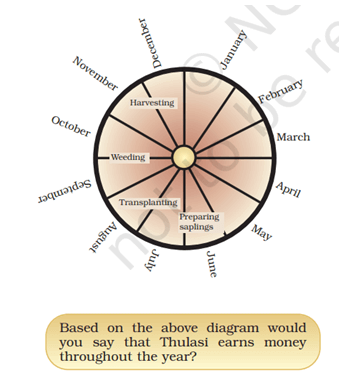
Answer:No, Thulasi can't earn money throughout the year because during summer season she has to be work-free in a village. So for livelihood she might be forced to migrate to the nearby towns.
Question 9. What work does Sekar’s family do? Why do you think Sekar does not usually employ labourers for doing farming work?
Answer:Sekar’s family work in the field like cultivating and growing crops. Sekar does not usually employ labourers for doing farming work because he owns a very small plot of land and it is cultivated by him and his family. If outside help is needed at the time of harvesting, he exchanges his labour with the other farmers.
Question 10. Why does Sekar not go to the town market to get a better price for his paddy?
Answer:Sekar does not go to the town market to get a better price for his paddy because he gets about 60 bags of paddy. Some of this will be sold to settle the loan and the rest will be used in his home. He does not have a surplus.
Question 11. Sekar’s sister Mina had also taken a loan from the trader. She does not want to sell her paddy to him but she will pay back her loan. Write an imaginary conversation between Mina and the trader’s agent and the argument given by each person.
Answer:
Mina: (Is sitting near her hut and the trader’s agent has come.) (There is fear in her eyes.) When the agent arrives she greets him politely and asks him to sit.
Agent: You have collected the paddy from the field I have come to buy it. After deducting the money taken by you as a loan, the rest of the money will be given to you.
Mina: I do not want to sell my paddy to you.
Agent: (In anger) Why? You do not have to go the market to sell it. I will save you time.
Mina: (Insists) I will give the loan.
Agent: (Rudely) I am asking why?
Mina: The market price is more and you are giving less.
Agent: Aha! We give money when you need it. Not the market. I will buy your paddy.
Question 12. What are the similarities and differences between Sekar and Thulasi’s lives? Your answer could be based on the land that they have, their need to work on the land, that belongs to others or loans that they need and their earnings.
Answer:The differences between Sekar and Thulasi’s lives are:
| Sekar | Thulasi |
|---|---|
| He owns a plot of land which is about 2 acres and works on his own. | She does not own way plot of land she works for big landowners. | He takes loans from the traders and to pay back the loans, he was to sell the paddy at a lower price. | When Thulasi took a loan, because her daughter was ill, she had to sell her cow. |
- Both are labourers and work on the land. They work from morning till evening in the paddy fields. They have to take loans.
- Both have to work to get additional money. Sekar works for Ramalingam and Thulasi has to do all household chores like collecting firewood and fetching water.
Question 13. Read about Sekar and Thulasi’s account. What do they say about Ramalingam the large fanner? Together with what you have read, fill in the details below.
- How much laud does he has?
Answer:Ramalingam owns about 20 acres of paddy fields in Kalpattu.
- What does Ramalingam do with the paddy grown on his land?
Answer:The paddy is used to produce rice in the rice mill, which is then sold to the traders in nearby towns.
- Apart from fanning how else does he earn?
Answer:The other sources of his earnings are:
- He gives loans to poor people and gets interested.
- He owns a rice mill and buys paddy from within the village and surrounding villages and profits are earned.
- He also owns a shop which sells seeds, pesticides etc.
Question 14. From the figures given in the textbook would you say that majority of the country’s farmers are quite poor? What do you think can be done to change this situation?
Answer:In India, about 2/5 rural families are agricultural labourers and what they earn is not sufficient to meet the expenses of the family. To improve their condition the government has to take necessary steps, e.g., to provide land, provide a credit on easy terms and give a high yielding variety of seeds, fertilizers, pesticides etc., help them in marketing their produce.
Question 15. Why do both Sekars and Arana’s families have to borrow? What similarities and differences do you find?
Answer:Both Sekar’s and Aruna’s families have to borrow because Sekar’s family owns about 2 acres of land and produces about 60 bags of paddy, which is not sufficient for his family. So he has to borrow money. Aruna’s family has to borrow money because four months in a year are the breeding season and men cannot go to the sea.
Similarities :
- Both have to work very hard, from morning till evening to earn their living.
- Both are under the clutches of the traders, from whom they have borrowed money.
Differences :
- Sekar is a small farmer and Aruna is a fisher-woman.
- Sekar has to do additional work.
Question 16. Have you heard of a Tsunami? What is this and what damage do you think it might have done to the life of fishing families like Aruna’s?
Answer:Tsunami is a Japanese word. It is made of two smaller words ‘Tsu’ and ‘Nami’. It is a killer wave. When the waves reach the coast, they gain both in height and speed. They cause wide destruction, wash away the villages. The villages are flooded with water debris floating on the water. It takes away everything which comes in its way.
The fishermen who live near the coast may have lost the huts and belongings. Many family members lost their lives and many children were either, orphaned or separated from their family.
Questions:
Question 1. You have probably noticed that people in Kalpattu are engaged in a variety of non-farm work. List five of these.
Answer:Five non-farm work of people in Kalpattu village:
- Making baskets, utensils, pots, bricks, bullock-carts etc.
- Blacksmiths
- Nursing
- Teaching
- Shop-keeping
- Trading
Question 2. List the different types of people you read about in Kalpattu who depend on farming. Who is the poorest among them and why?
Answer:Different types of people who depend on farming are:
- Big landowner
- Small landowners or Farmers
- Landless farmers or Labourers
Question 3. Imagine you are a member of a fishing family and you are discussing whether to take a loan from the bank for an engine. What would you say?
Answer:If I were a member of a fishing family then I must have taken loan from the bank for an engine to improve and to invest in the growth of the business. The engine is very costly and bank is a trusted institution from where we can borrow money. They have fixed terms and rates. They will not ask for shares in our profit and are reliable. Moreover, buying an engine will increase the income.
Question 4. Poor rural labourers like Thulasi often do not have access to good medical facilities, good schools, and other resources. You have read about inequality in the first unit of this text. The difference between her and Ramalingam is one of inequality. Do you think this is a fair situation? What do you think can be done? Discuss in class.
Answer:The situation is not fair in aspects of constitution of India. The constitution grants every person to be equal in terms of the provision of the facility. However, to be access to good medical facilities, good schools, and other resources there are many factors which can be responsible. A person might have worked very hard and earned money to provide himself good facilities rather than the others.
But, it is also the duty of the government to ensure atleast the good basic facilities to every citizen of the country irrespective of their income. The government can provide them loan for work, farming land, low cost fertilisers and seeds, setting up hospitals etc. to help them.
Question 5. What do you think the government can do to help farmers like Sekar when they get into debt? Discuss.
Answer:The government can do following things to help farmers like Sekar when they get into debt:
- Provision of easy farming loans from the banks at low rate of interest.
- Insurance of their cultivation.
- Provision of subsidised fertilizers, pesticides and HYV seeds.
- Farming schools and help should be provided at no cost.
Question 6. Compare the situation of Sekar and Ramalingam by filling out the following table:
Answer:
| Sekar | Ramalingam | |
|---|---|---|
| Land cultivated | About two acres. | About twenty acres. |
| Labour required | No labour required. Help is taken from other farmers during harvesting. | He hires labour to cultivate the large land. |
| Loans required | He requires loan for seeds, fertilizers, pesticides etc. He takes loan from the trader. | He takes loans from govt, bank of establishing a rice mill. |
| Selling of harvest | He sells a few bags of paddy to pay back the loan. | Sells harvest to the traders or directly in the market, at the market price. |
| Other work done by them | He has a hybrid cow, whose milk he sells in the local milk cooperatives. | He owns a rice mill and a shop selling seeds, pesti-cides etc. |